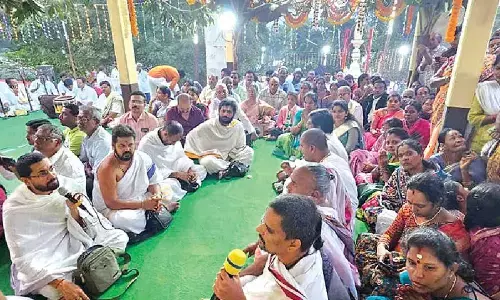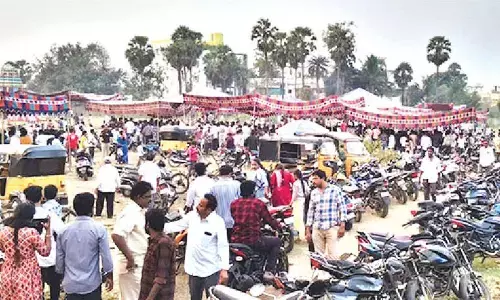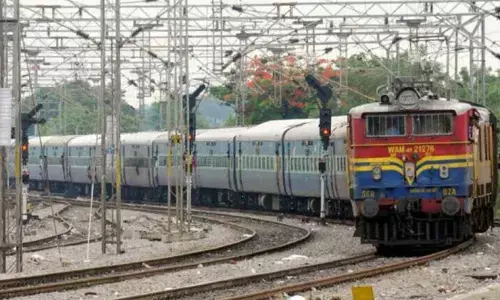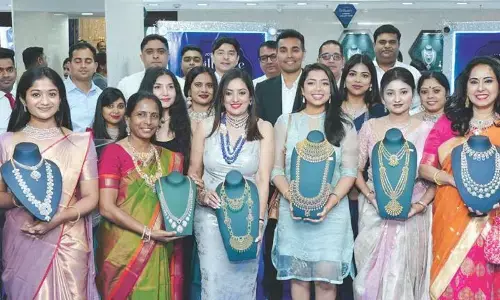Torchbearers of Telugu literature
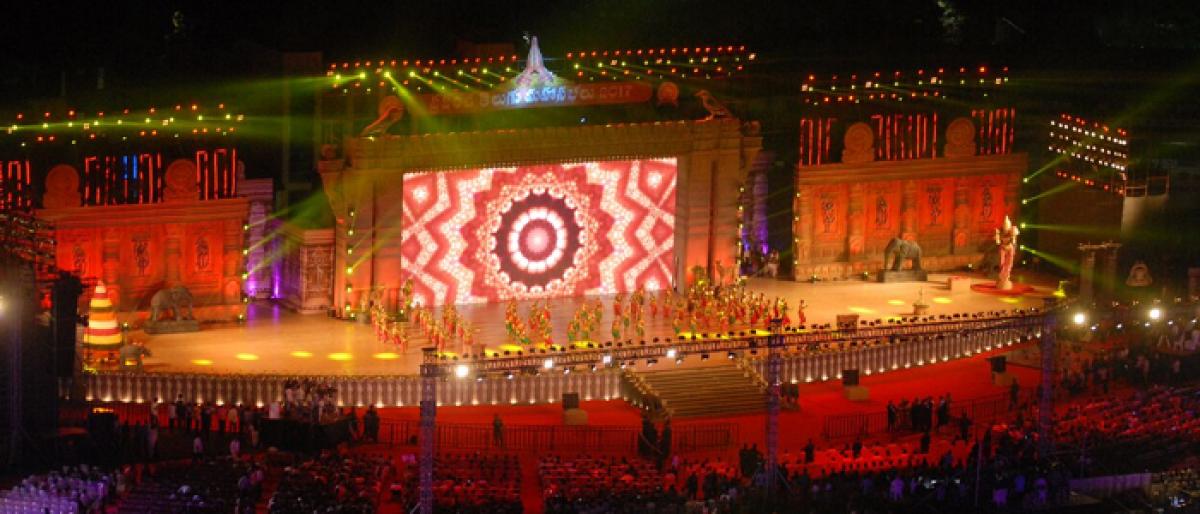
The beginning of the 15th century takes us to Koravi Goparaju (1430-1490) from Bhimgal of Nizamabad district who compiled the first collection of stories in Telugu, ‘Simhasana Dwatrimsika’
The beginning of the 15th century takes us to Koravi Goparaju (1430-1490) from Bhimgal of Nizamabad district who compiled the first collection of stories in Telugu, ‘Simhasana Dwatrimsika’.
His trail was followed by Ananta Amatya (1434) with his ‘Bhoja Rajeeyam’, Jakkana (1450) with his ‘Vikramarka Charitra’, and Dubagunta Narayana (1450-1500) with his ‘Panchatantra’. All of them were translations from Sanskrit. And in Dwipada metre, Gourana wrote ‘Navanatha Charitra’ and ‘Harischandropakhyanam’. Daggupalli Duggana wrote ‘Nachiketopakhyanam’, a story from Kathopanishad. Thus it was a period of stories to reach out to the populace.
Next is the age of Prabandhas (1510-1600). A prabandha is a fictional or semi-fictional narrative in poetic form covering non-religious themes like romance and chivalry. The prabandha literature reached its pinnacle during the times of Srikrishna Devaraya; and the literary glory of his court compares well with that of King Bhoja.
The post-Prabandha period also was equally grand. We find many similarities between Srikrishna Devaraya of Vijayanagara and the Andhra king Raghunatha Nayaka of Tanjavur. Be it the victories in battles, the patronage of arts & letters, the creation of pristinely aesthetic literature, the musical prowess or the construction of temples – both of them were equal.
Raghunatha Nayaka’s royal court had the same sparkle as of Srikrishna Devaraya’s ‘Bhuvana Vijayam’. Raghunatha’s minister Govinda Deekshita, a master of both muse and music, wrote Sringara Savitiri, Nala Charitra, Valmiki Parijatapaharanam and several others. Vijaya Raghava Nayaka – son of Raghunatha – was also a poetic creator. His court had a place of prominence for women artists like Rangajamma and Madhuravani who were savants in eight languages.
Now let us move on into the Khammam district. The lore of the Bhadradri temple – together with Lord Rama, the Godavari meandering by, and his ardent devotee-composer Ramadasu, originally Kancharla Gopanna (1620-1680) – has been intertwined with the Telugu ethos.
His poignantly devotional kirtanas, especially as sung by Mangalampalli Balamuralikrishna, transport us to a realm of spiritual sublimity. Instead of trying to make technical or quantitative comparisons with Annamayya or Tyagaraja, one would do well to appreciate and imbibe their common denominator – the realisation of the divine.
Like the Andhra Mahabharata, even the Andhra Maha Bhagavatam also came to be translated by more than one poet to complete it. The 12-book (Skanda) tome was translated by four poets, with eight by Potana; one by Gangana (Skanda 5); one by Singana (6); and two by Veligandala Naraya (11, 12). Critics opine that Potana gave the opportunity of translating four books to his three disciples. He was an intense devotee and infuse every episode with fervent emotion and aesthetic beauty.
This consummate aesthetics is the élan vital of Potana’s translation. When we come down to the modern times, the English literature prompted the creation of romantic and lyrical poetry in Telugu. Poets were not confined to any particular subject or theme. Rayaprolu Subbarao took to this new genre, and he suffused his works like ‘Snehalata Devi Kathalu’, ‘Andhrula Charitra’ and ‘Andhra Mata’ with what he called Amalina Sringaram – unsullied or Platonic love or spiritual friendship.
There are some more noble souls to whom we remain forever indebted. A number of committed researchers like Komarraju Venkata Lakshmana Rao, Mallampalli Somasekhara Sarma and Adiraju Virabahdra Rao traversed the country seeking out and deciphering inscriptions; poring over ancient manuscripts in libraries at places like Rajamahendravaram and Tanjavur; investigating and emending them; compiling encyclopaedias like ‘Andhra Vignana Sarwaswam’; and penning valuable and path-breaking editorials and essays.
We owe immeasurable gratitude to Colonel Mackenzie (1754–1821), the first Surveyor General of India, and CP Brown (1798-1884), compiler of Telugu-English-Telugu dictionaries – for having brought to light many of our hidden literary treasures and motivated many a native savant into research. Among the eminent assistants of CP Brown were the likes of Vasudeva Parabrahma Sastry and Juluri Appaiah. It was Brown who had discovered Vemana for us.
The land of Telangana, has all through, been sanctified by the presence of a host of literary illuminati. Adiraju Virabhadra Rao, remembered as Telangana Bhishma, played a prominent part in the renaissance of Telugu in Telangana and in the library movement, and was secretary of Srikrishna Devaraya Andhra Bhasha Nilayam, Hyderabad.
Born at Dendukuru village near Madhira of Khammam district, he is known for his historical works, and his books include – Prachina-Andhra Nagaramulu, Lalita Kathavali, Ratnaprabha, Jeevita Charitavali, Navvula Puvvulu, Mithai Chettu, Shitab Khan.
Kappagantula Lakshmana Sastry was the poet laureate in the royal court of Wanaparty. A savant in seven languages, he rendered the Vyasa Mahabharata into a facile prose appealing to the populace. A Sanskrit scholar extraordinaire, he taught at Dr Sampoornananda Sanskrit University, and received the title Andhra Bilhana. Burgula Ramakrishna Rao and PV Narasimha Rao were his prominent disciples.
Guduri Sitaram, born at Hanumajipet near Siricilla, the birthplace of C Narayana Reddy, wrote about 80 short stories of which Maa Raju, Lachchi, Pichchodu, Rajamma Rajarikam are well known. He served as secretary of the Telangana writers association in 1953.
Suravaram Pratapa Redddy, a polyglot and researcher, is famous for his monumental work ‘Andhrula Sanghika Charitra’ (a compilation of the social history of the Telugus). Published in 1949, it won the Sahitya Akademi award and ran into many editions, and his other great work is Golconda Kavulu which, by covering 354 poets from Telangana, traces the literary credentials of the region. He commented that while the Telugu of the Andhra region was influenced by English, that of Telangana was influenced by Urdu.
Dasaradhi Krishnamacharya’s ‘Timiramto Samaram’ also won the Sahitya Akademi award. Suddala Hanmanthu, father of well-known film lyricist Suddala Ashok Teja, was an activist in the anti-Nizam struggle, and he came up with inspiring songs like Palleturi pillagada… pasulagaase monagaada. Vattikota Alwaru Swamy was also a revolutionary poet, who recorded his experiences in his jail memoir ‘Jailu Lopala’, during his incarceration itself. He also wrote two novels ‘Prajala Manishi’ and ‘Gangu’.
Samala Sadasiva, born at Tenugupalle in the Dahegaon Mandal of Adilabad district, was also a multilinguist, and he authored – ‘Yadi’, a history of Urdu literature, ‘Amzad Rubayeelu’, and ‘Malaya Marutam’. An authority on, and a bridge between, both the Hindustani and the Carnatic classical music, he wrote ‘Swaralayalu’, a Sahitya Akademi award winner.
Freedom fighter, polyglot and former Prime Minister PV Narasimha Rao translated the Telugu mega novel ‘Veyipadagalu’ of Viswanatha Satyanarayana into Hindi as ‘Sahasraphan’, besides penning “Insider,” his autobiography in English.
Viswanatha, the first Jnanpith Telugu laureate, while being the principal of SRR Degree College at Karimnagar endeared himself to the Telangana litterateurs. During his Karimnagar stint, he wrote as many as 30 books and dedicated two of his poetic collections to the Telangana scholars – ‘Kedara Goula’ to Velchala Keshav Rao, father of Dr V Kondal Rao; and ‘Bhrashta Yogi’ to Juvvadi Goutham Rao who popularised Viswanatha’s ‘Ramayana Kalpavriksham’ by singing out the poems from it, like a minstrel. Goutham Rao and Kondal Rao were Viswanatha’s colleagues at Karimnagar. Kondal Rao, doing a lot to promote Viswanatha’s literature, got the ‘Veyipadagalu’ mega-fiction translated into English. And Viswanatha’s ‘Kinnerasani Patalu’ brimming with poetic creativity is an immortal ode to Kinnera, a tributary to the Godavari near Bhadradri.
Viswanatha used to call Adivi Bapiraju as ‘Baapi Baava’, and Bapiraju also had a memorable association with Telangana. As editor of Meezan, a Telugu daily from Hyderabad (1944-1947), he related to the Telangana writers and people. His historical novel ‘Gona Ganna Reddy’, about the eponymous Kakatiya hero, opens a window on the critical politico-military scenario during the Kakatiya times, in vivid detail. By researching and mastering the historical sculpture of Telangana, he declared that Telangana alone was the true Telugu land (Kulapati, 1954, Ed. Ravulaparti Bhadriraju, p 5). He was also a member of the Ramappa temple renovation committee in 1932, chaired by Pingle Venkatrama Reddy. No wonder when Adivi Bapiraju passed away, the people in Telangana held condolence meetings for nearly six months.
Of late, people are getting increasingly attracted to yoga and devotion, and to the related literature, which is why we have a sizable sprinkling of religious and spiritual publications. The volumes on Andhra Yogis by Biruduraju Ramaraju; and the Telugu rendition by Poranki Dakshinamurty of Paramahansa Yogananda’s ‘The Autobiography of a Yogi’ come under this category.
Kaloji Narayana Rao, whose birthday is commemorated as the Telangana Language Day, was an anti-Nizam and rights activist, born in Warangal. A polyglot, he wrote many books like ‘Kaloji Kathalu’ and ‘Naa Godava’ series. Jnanpith recipient and distinguished film lyricist C Narayana Reddy did an extensive research and brought out his doctoral thesis on modern Telugu poetry, which is still an authority on the subject.
There is a need to carry out studies on the subsequent literature down to the current day to keep his work alive. He is remembered for his Telugu ghazals, and they were further popularised by singer Ghazal Srinivas who went about and belted them out like a troubadour.
In this write-up, we haven’t mentioned the living writers, and there is a legion of names that couldn’t be cited, and scores of aspects that couldn’t be touched upon – due to constraints of space. Tributes to them all.
The lyrical productions by musical maestros; scientific books and articles; fiction and plays; proliferating newspapers and journals, both print and web; the bountiful media presenting an endless series of serials… are all kicking alive. In sum, wow, what a rich literature we the Telugus have! Conjuring up its variety and vigour in itself causes goose-bumps!
Let us hope that the initiatives by Chief Minister KCR, a keen student of Telugu literature himself, to develop and promote the cause of Telugu, a sweet-cum-savoury tongue – would bear fruit. Instead of trying to score brownie points on the relative literary primacy in the two Telugu states at a demagogic or lay level, let’s leave the matters of research and historical evidence to the domain of scholars.
A minute proportion of expressional or usage variations – rooted in historical or dialectal factors – should not be allowed to deny the very basis and the overarching commonalities of our rich language. And, ultimately it doesn’t matter which region is scientifically proved to be first in which aspect, for the real beneficiary will be nothing but the language and literature.
Therefore, let’s all aspire to a synergic cooperation to blossom and flourish between the two Telugu states to open a glorious chapter for the Telugu language and literature, a la the seamless unity among the Hindi states. Jai Telangana! Jai Andhra! Jai Telugu! Jai Hind!
Syamala Devi is a PhD in Telugu Literature
Atreya Sarma is Chief Editor, Muse India








